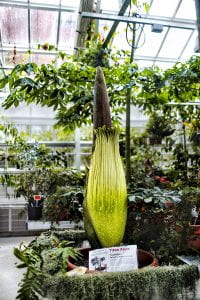
Cornell Chronicle [2019-09-11]:
Carolus, one of Cornell’s two Titan arum plants, also known as “corpse flowers,” will again unleash its fetid odor in the Liberty Hyde Bailey Conservatory on Tower Road in the coming days.
“The flowering is brief – just a day or two – and difficult to predict,” said Paul Cooper, the Cornell University Agricultural Experiment Station greenhouse grower who cares for the Titan arums and more than 600 other species of plants in the conservatory. “But the bloom is nothing if not memorable.”
That’s because the Titan arum (Amorphophallus titanum) – native to the jungles of Sumatra, where it is threatened by habitat loss – has a fascinating pollination strategy: It releases volatile chemicals that smell like a rotting carcass to attract flies and carrion beetles to transport pollen from one plant to another.
The plant also warms to more than 100 degrees, to help waft the foul scent up into the canopy so it can travel far and wide. Skunk cabbage, a related plant native to the Finger Lakes, uses a similar strategy when it flowers in early spring, often melting surrounding snow.
Titan arums also produce the tallest unbranched flowering structure in the plant world, towering higher than 108 inches (9 feet). The last time Carolus flowered, it reached 75 inches tall; as of Sept. 11, it already stood 88 inches – making it the tallest Titan arum ever grown at Cornell – and was growing about five inches a day.


